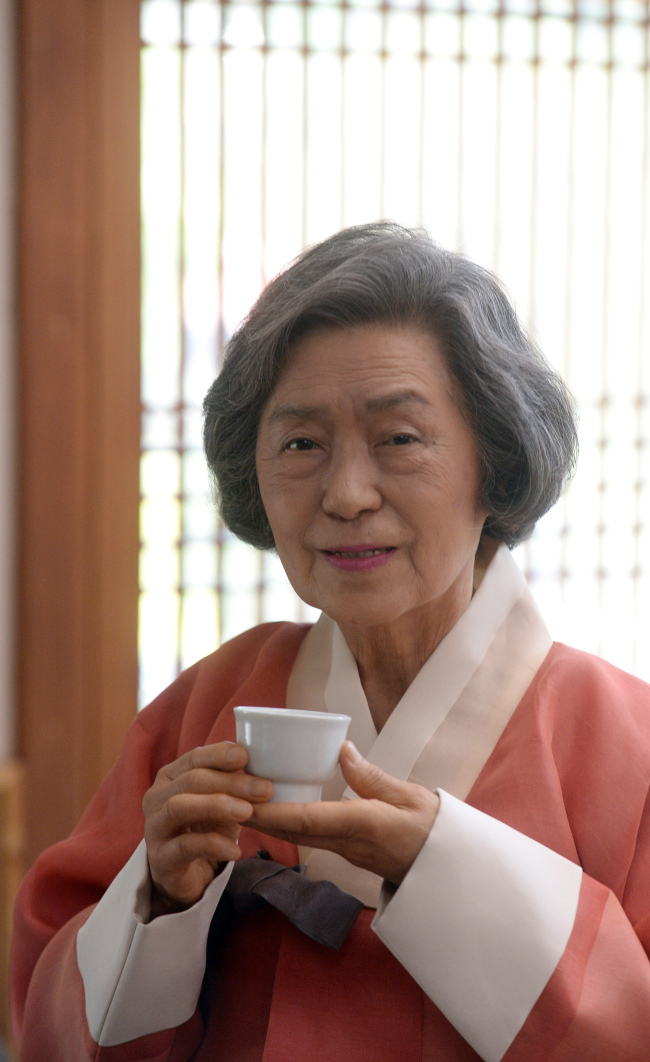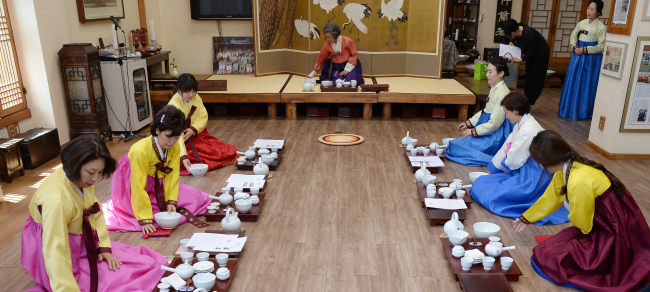
Traditional Korean tea-drinking is not just about the beverage.
It’s based on the harmony of all aspects involved in the process, including nature, attire, interior setting, teaware and people, explains Kim Eui-jung, who is recognized as Korea’s 27th intangible cultural asset for her expertise in traditional royal tea ceremonies.
Kim’s mother, Kim Mi-hee, in 1980 helped restore Korea’s unique tea tradition which had been passed down for hundreds of years since the Goryeo dynasty (918-1392) but was cut off due to the Japanese occupation.
Since then, the Kim family has been operating the Myungwon Cultural Foundation, which preserves and promotes Korea’s traditional tea culture.
 |
Kim Eui-jung, Korea's intangible cultural asset No. 27 for her expertise on traditional royal tea ceremonies (Ahn Hoon/The Korea Herald) |
Korea’s tea etiquette is based on virtues such as respect, cleanliness and moderation, and an appreciation of one’s inner self as well as one’s surroundings and acquaintances, Kim explained on Tuesday at the foundation’s tea education center.
The center holds classes on tea etiquette and grows its own tea leaves in its backyard. The building is a renovated hanok, or traditional Korean house, located on a serene mountainside in northeastern Seoul. Only the youngest and softest budding leaves are picked at the center and processed into green tea, said Kim.
“You begin to pay careful attention to even the smallest things when you sit down to serve a cup of tea,” she said. “You look at the beauty of the tea cups and dishes. You make sure each tea towel is spotless and creaseless. You become quiet and listen to the wind and birds outside. Then you drink the tea and taste its subtle scent spreading inside you. It’s a healing process.”
 |
Students take a class on etiquette for traditional tea drinking at Myungwon Cultural Foundation's tea education center in northeastern Seoul on Tuesday. (Ahn Hoon/The Korea Herald) |
That’s why tea education is a useful tool in teaching children about the virtues of serenity and respect, she said.
“Korean tea etiquette is about being at one with nature, as calm as the tea flowing out of the teapot,” Kim said.
The first step to drinking tea is to make sure that all ingredients and teaware are carefully cleaned.
It is also important to keep a straight posture at all times when seated on the floor with a tea set in front of you, she added.
“Korean tea etiquette involves a meticulous but calming process,” she said.
Both hands must be used to gently pour water into a porcelain kettle. The tea leaves are then placed into the kettle and left to steep. Next, the tea is poured into small teacups, which should ideally be emptied within three sips. Snacks prepared with seasonal ingredients accompany the tea.
“You should always serve your guests first, humbling yourself and respecting the person in front of you,” Kim said. “By carrying out this process outwardly, you are inwardly showing respect.”
By Rumy Doo (
doo@heraldcorp.com)









![[Today’s K-pop] Blackpink’s Jennie, Lisa invited to Coachella as solo acts](http://res.heraldm.com/phpwas/restmb_idxmake.php?idx=644&simg=/content/image/2024/11/21/20241121050099_0.jpg)
